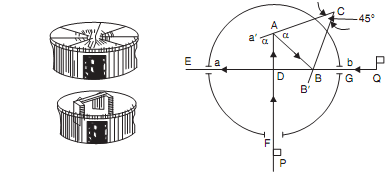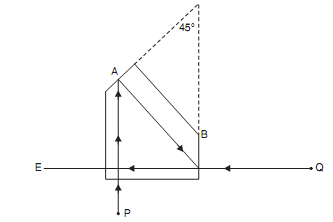Perpendicular Offsets Using Optical Square and Prism Square
These instruments are based on the optical principle that if 2 mirrors are at angle 'θ' to each other, they will reflect a ray at angle '2θ'. Given figure shows a typical optical square.

(a) (b)
Optical square
Optical Square consists of metal box approximate 50 mm in diameter and 125 mm deep. In the rim of the box there are 3 openings which are following:
1) a pin hole at E
2) a small rectangular slot at G, and
3) a large rectangular slot at F.
A and B are the 2 mirrors placed at 45º to each other. Therefore the image of an object at F which falls on A gets reflected and emerges at E which is at right angles to the line FA. Mirror A which is opposite to the opening at F is wholly silvered. It is fitted to a frame that is attached to the bottom plate. By inserting a key on the top of the cover if essential this mirror can be adjusted. Mirror B which is in the line with EG is silvered in the top half and it is plain at the bottom half. It is attached to the bottom plate of the box firmly.
The ranging rod at Q is sighted by eye at E in the bottom half of the B directly, which is a plain glass. In the top half of B at the same time, the reflected ray of the object at P is sighted. When the image of P is in the identical vertical line as the object at Q, then the lines PA is at right angles to the line EB. For finding foot of the perpendicular or to set a right angle this instrument may be used.
Instead of two mirrors at 45º to each other a prism which has two faces at 45º to each other is used, in prism square .Its advantage is even after long usage it will not go out of adjustment .

Prism square